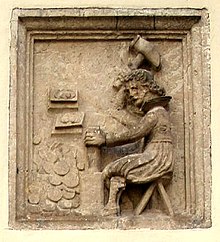Embossing stamp
An embossing die (as a coin die or coin die ) is the classic forming tool in coin and medal production , but is also used in the processing of paper and comparable materials. A common application is, for example, embossing on documents .
Working method in coinage
When minting coins , two stamps ( coin dies ) act simultaneously on the prepared coin blank in order to mint the front and back of the coin. One example is the hammer embossing , which has been known since ancient times .
Another example is ring embossing . Here the coin blank is pushed into an embossing ring , often with a feed tong . After the blank has been inserted, the two dies move simultaneously towards the blank from above and below. The coin is minted with a pressure of up to 200 tons . The way of working is similar with paper stamps.
particularities
If the front stamp is coupled with the back stamp of another coin for the minting of the coin, it is a hybrid coin . This embossing is called a hybrid embossing.
If the stamp is too hard, a material defect or the relief of the coin image cut into the stamp by the medalist is too high, the stamp may tear (stamp break) during minting. The coincidental appearances that arose in this way in the coin image, such as the tear of the stamp through the neck of the Lord Protector on the Cromwelltaler from 1658 or the broken Kurschwert of the Elector Johann Friedrich the Magnanimous of Saxony on some Schmalkaldic Bundestalers from 1547, the year of his capture , were thought to be a good or bad omen in retrospect, before the Enlightenment.
The die crack shows up on the mint as a bulge, i.e. raised, and is considered a minting error, which, however, as mentioned in the two examples, can exceptionally increase the value of the coin considerably.
It also happened that, due to considerable disagreements, newly minted thalers (example Wasertaler ) were confiscated and then overminted with other coin dies . Any traces of the other stamp from the previous embossing testify to this process.
literature
- Helmut Kahnt , Bernd Knorr : Old measures, coins and weights. A lexicon. Bibliographisches Institut, Leipzig 1986, licensed edition Mannheim / Vienna / Zurich 1987, ISBN 3-411-02148-9 , p. 391 ( coin mark ).
References and comments
- ↑ Heinz Fengler, Gerd Gierow, Willy Unger: transpress Lexikon Numismatik , Berlin 1976, p. 429
- ↑ Coin image: totality of the pictorial character of a coin. See Helmut Kahnt, Bernd Knorr: Old measures, coins and weights. A lexicon. Bibliographisches Institut, Leipzig 1986, licensed edition Mannheim / Vienna / Zurich 1987, ISBN 3-411-02148-9 , p. 388.
- ↑ Wolfgang Eichelmann: Thoughts and Considerations on Coins of the House of Brabant, Münster 2010, pp. 58–66.

